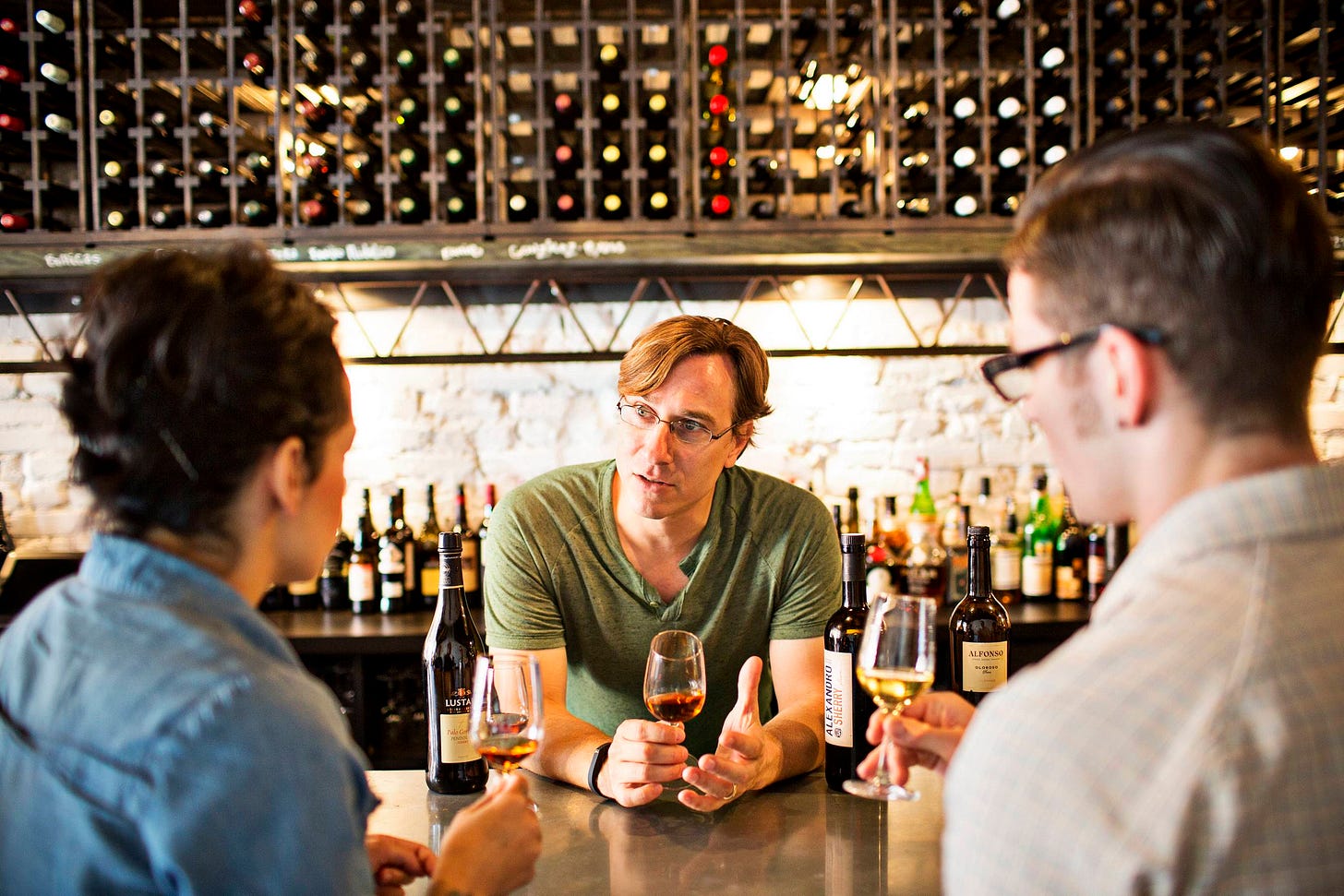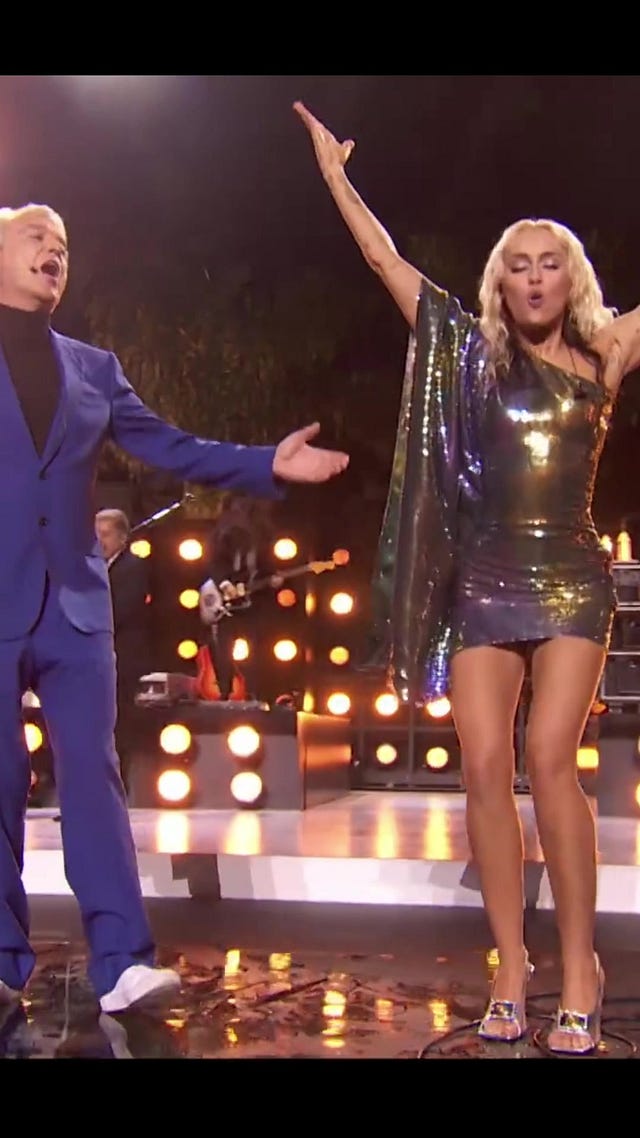On Talking Heads and Sherry Heads
The ultimate low-alcohol cocktail base works exactly because it’s weird and complex, not despite it
Did you catch Miley Cyrus perform with David Byrne this past New Year’s Eve at “Miley’s New Year’s Eve Party” on NBC?
Miley is a rare talent who has grown from child star to pop icon. Still, she continues to amaze me with the depth of her interest, covering industrial band Nine Inch Nails and inviting legendary new-wave septuagenarian singer, David Byrne, to perform with her for New Year’s Eve. Byrne was formerly of 2002 Rock & Roll Hall of Fame inductees, Talking Heads.
Despite being an interesting combo, it was awkward, to say the least.
And, though I deeply appreciated the performance, there was an underlying dissonance. Miley is weird and cool. David Byrne may or may not be cool in 2023, but he is undoubtedly weird.
As he crooned and shrugged his shoulders up and down, while bouncing (the best way to describe his dancing), I was immediately reminded of the fortified wine, Sherry. From time to time it has threatened to be cool, and has even been endorsed by those who make cool things for a living, me for one. But, regardless of whether that threat has been realized, it’s always been weird for Americans.
That, of course, is also its strength in low-alcohol cocktails.
Sherry’s weirdness—by which I mean its complexity, harboring an array of volatile compounds that give it a staggering range of aromas and flavors—is how it shines through the mixers, syrups, and bitters that suppress other low-alcohol ingredients in cocktails. We’re talking about flavors ranging from green apple, marzipan, and cheese to smoke, vanilla, spice, and wood.
Sherry is actually not one wine but a group of dry and sweet wines that come from the south of Spain in Jerez. I’m mostly talking about the dry wines that are made from the palomino fino grape and aged and blended. These wines undergo the “three Fs,” as I like to call them:
Flor - Biological aging under a coat of yeast cells.
Fortification - The addition of un-aged brandy.
Fractional Blending - Blending different vintages to achieve a standard profile.
Sherry has six main styles: Fino, Manzanilla, Amontillado, Palo Cortado, Oloroso, and Pedro Ximenez (PX). I’ll skip going into too much depth, but a good, five-minute primer can be found here.
For the sake of cocktails, it’s easy to remember the darker the Sherry the more age and potential sweetness it may have, whether that sweetness is perceptual—with Oloroso having whiskey-like confectionary qualities such as vanilla and caramel—or actual, like PX that is syrupy sweet and tastes like raisins. PX is often poured over ice cream.
Nowhere does Sherry’s prowess in cocktails shine more than in the Sherry Cobbler. I love to trot this cocktail out as the prime example of how Sherry is a fantastic base for low-alcohol cocktails.
For all intents and purposes, the Sherry Cobbler should be a sweet, fruity drink. It’s made with wine, fruit, and sugar, and served over crushed ice. In fact, the Cobbler should be a pool drink alongside the Piña Colada and Strawberry Daiquiri. But it’s not. It has more oomph than both of those drinks. And, while it’s refreshing and can certainly be drunk poolside, it’s also nutty, rich, and complex, making it better bedfellows with classic cocktails such as the Old Fashioned and Mint Julep.
I use Oloroso Sherry in my Sherry Cobblers because it provides the best backbone and has depth and layers of flavor. Oloroso is also the highest alcohol Sherry, about half the alcohol by volume (ABV) of most whiskey. Does that classify the Sherry Cobbler as a low-alcohol cocktail? I’ve got a post for that, but it does come in at 10.5% ABV, which is less than a glass of wine and about twice that of light beer. You can certainly use Amontillado or Palo Cortado Sherries as well, which will reduce the ABV even lower.
Sherry works well in low-alcohol cocktails and is bursting with flavor. But the question remains, will it ever be cool in the United States?
As I once told writer and podcaster, Jason Wilson of Everyday Drinking: “This is something that people in the industry don’t want to hear, especially those advocating for Sherry, but it’s never going to happen, man.”
Just as Miley Cyrus bringing David Byrne on stage is not likely going to lead to a renaissance of the Talking Heads. Weird and complex are just not things that generally appeal to an American palate. And, while it may sound depressing on the surface, it’s actually right as it should be. There is, in fact, a place for it.
As I also told Wilson on his podcast, “Maybe Sherry is just for us.”
Learn how to make low-alcohol cocktails from my three-part course with Atlas Obscura, Session Cocktails: Low Alcohol Mixology with Derek Brown. Classes start tonight but are also recorded if you cannot attend any of the live sessions.
My book “Mindful Mixology: A Comprehensive Guide to No- and Low-Alcohol Cocktails” was just listed as one of the top four finalists for “Best New Cocktail or Bartending Book” at Tales of the Cocktail’s Spirited Awards.
Sherry Cobbler 10.5% ABV
One Serving/ 12-14 ounce Highball or Double Rocks Glass
2 ounce Oloroso Sherry
½ ounce Simple Syrup*
2 thinly-sliced Orange Wheels
Cherry and Mint Sprig for Garnish
In a shaker, combine Sherry, simple syrup, and one orange wheel. Shake vigorously. Pour into glass, add crushed ice, and garnish with remaining orange wheel, cherry and mint.
* Measure equal parts sugar and water (1:1), weight is best but eyeballing works, too. Combine sugar and water in a sauce pan and heat until the crystals dissolve. Once cooled, the syrup can be used.
Derek Brown is an author, NASM-certified wellness coach, and founder of Positive Damage, Inc.
This newsletter is free and public. Share with anyone you think will enjoy it.








